“The bow and arrows of days gone by
Live still today through you and I.”
From “The Legacy,” by Ron LaClair
It makes sense that a diehard archer and bowhunter like Ron LaClair would be born and raised in Michigan. That state has always been in the forefront of the outdoor lifestyle, producing generations of hunters and fisherman and, especially important to us, people like Fred Bear, Will Compton and countless other bowhunting leaders. Michigan archers played a major role in the archery explosion that took place in this country from the 1940s through the 1960s. Ron LaClair was born in 1936, and grew up hunting deer in Michigan with bow and arrow.
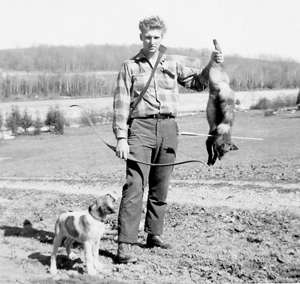
A younger Ron with a fox he shot on the run.
I met Ron for the first time at an archery event at Fox Valley in Aurora, Illinois in the late 1970s. I had just started building and selling Bighorn Bows, he had just opened the Traditional Archery Shoppe, and we both were trying to sell our wares. They likely put us side by side because we were the only traditional vendors, the compound bow having gobbled up most traditional bow companies of any size by then. Ron was in the forefront of what would later be called “the longbow revolution” that sprang to life in the 1980s. At the time, mine was the only traditional company advertising recurve bows, so we talked a lot that weekend. In the ensuing years I’ve gotten to know Ron and realize what an asset he and his dedication to traditional archery have been to all of us who follow the traditional banner, and what a unique, talented, and interesting individual he is. But you’ll have a better appreciation of Ron LaClair if we start at the beginning.
GFA: Tell us about your start in archery.
RLC: My first bow was a little wooden thing with suction cup arrows, and I remember my mother reading Robin Hood to me, and my imagination running wild through Sherwood Forest, battling the sheriff’s men, longbow in hand. I’m not sure whether the bow came first or the story of Robin Hood, but I am sure that both were major factors in all that’s happened in my life since then. I must have been five or six, and I remember being banished to the outdoors with the bow and arrow in the best interest of my mother’s home furnishings. My dad had wood working tools and early on he made me a “proper” bow with arrows, and I was immediately out hunting frogs along the nearby creek. I remember bringing home a couple of frogs and Dad saying if I killed them I should eat them and showing me how to clean them and how to fry them up in a pan. That was almost seventy-five years ago, and I remember every moment of it. It was when I became a hunter.
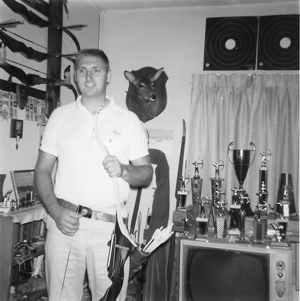
Ron started accumulating trophies for his talented mastery of the bow at a young age, and still shoots with that enormous talent today.
GFA: And that’s probably what got you started as a camp cook. Right? I’ve witnessed your campfire skills, and you’re a heck of a serious cook. And from what I’ve seen you take particular pride in creating wonderful meals from what you’ve harvested, from cottontails to buffalo.
RLC: That’s probably right. My mom and dad were a big influence on me. In 1945 when I was nine years old I got my first “real” bow. It was from Montgomery Wards and was, I think, lemonwood. We lived on a farm at that time, and I had a pinto pony named Scout and an Indian costume complete with feathered headdress. With my bow and pony, I roamed the woods and fields shooting imaginary deer and buffalo. A couple of years later when I was eleven, I went to a summer camp in northern Michigan where they had all the things boys loved including swimming, rifle shooting, camp crafts and bow shooting. I, of course, loved the bow shooting and had no interest in going on to the other classes once I’d got a bow and arrow in my hands. At some point the camp counselors called my parents telling them that I didn’t want to do anything except shoot the bow, and my dad told them to “just let him shoot the bow then.” So I spent all my time at the camp shooting arrows. I remember that I beat everyone’s score by at least a hundred points at the end. I still have that diploma, by the way.
We moved back to town in 1948. I no longer had a place to shoot, and my shooting suffered for several years. In 1951 when I was fifteen, I purchased a 52# Par-X all aluminum bow from a secondhand store and shot that for a while, mostly at telephone poles along the railroad tracks close to the house. In 1955, I bought a new 52-pound Bear Kodiak and went bowhunting for the first time in northern Michigan. I was nineteen years old. My Uncle Dallas was a hunting and fishing guide in northern Michigan. He took me to the Jordan Valley State Game area and set me up in what he said was “the perfect place,” and it was that. I had my first encounter with a deer, and with buck fever, on that hunt. The arrow didn’t come close, and I can still see it all as though it happened yesterday.
GFA: It seems that you’ve been involved in just about every aspect of archery since the early 1950s. Fill us in.
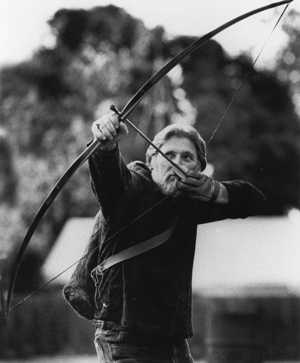
Here Ron is performing trick aerial shooting at one of the large traditional gatherings in Michigan.
RLC: Well, as I’ve said, I picked up a bow in the late forties (that’s seventy-five years ago!) and have basically never put it down. I shot and hunted through the fifties as I was coming of age. Nancy and I got married in 1959, and we both loved shooting bows and being outdoors together. The NFAA and field archery were huge in those days, and every community had a course. We traveled all over and shot someplace every weekend. Shooting with a sight was known as free-style and it was very competitive and was where all the best shooters were and, being a competitive sort of fellow, I went for that, although I continued shooting my hunting bow instinctively.
The most prestigious shoot in those days was an indoor event at Cobo Hall in Detroit, which drew archers from all over the world. I shot on the Michigan Team, which was made up of the best shooters in the state, and some of those guys were among the best in the country. I won’t go so far as to say that I was, but I was up there with them and part of that team. I was always proud of that.
GFA: So you shot a target weight bow with a sight competitively and switched to shooting instinctively during the hunting season? And then you became an exhibition shooter, too? That takes a lot of talent.
RLC: I did it for many years and never had a problem with it, and I guess I never thought of it as anything more than my love for the bow and arrow.
GFA: Going from being a competitive sight-shooter to a longbow proponent is a big step. How did that come about?
RLC: Around 1970 the compound bow came along and totally changed archery. Most people embraced the compound because it was so much easier to shoot and, in the end, made them a better shot. For me, the compound didn’t even look like the bow I had loved all my life, and I wanted no part of it. Eventually I dropped out of competitive archery and for the next six or seven years I simply bowhunted with my recurves. Sometime in the late 1970s I came across a copy of the Longbow Shooter’s Digest, which was a tabloid-style newspapery sort of thing, dedicated to the old style longbow and Howard Hill. I’d read Hill’s Hunting the Hard Way and was immediately intrigued by the idea of going back to the basics of the old longbow. I jumped into it head first. I bought a longbow from Howard Hill Archery and took a deer with it that first year. Oh man, was I hooked.
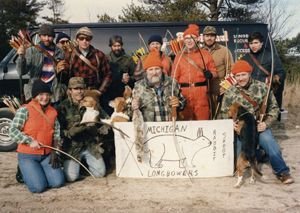
A group of friends at the Michigan Longbowers’ annual Rabbit Shoot.
But there wasn’t anyone around shooting longbows back then and I started trying to get my friends interested. It took some talking for sure, because the longbow requires a different approach. But eventually a few of my buddies joined in, and we would get together and shoot at local 3D ranges. It was all about Howard Hill back then, and we started shooting at stuff thrown in the air—disks, balls, and coins—like the films showed Howard doing it. A guy named Fred Trost, who had an outdoor TV show, saw us shooting and put footage of me on one of his shows. It sort of took off from there. The publicity was great, and it really got the longbow going. Nancy and I started going to shoots and events again, this time with the longbow. I took along copies of Longbow Shooter’s Digest to pass around and sell. In 1980 I started up an archery shop in my home, building a small shop on the property in ’86, selling just traditional stuff.
GFA: Tell us about winning the World Longbow Championship.
RLC: The championship was held in 1980 in Wilsonville, Alabama, which is just down the road from Howard Hill’s home in Vincent, Alabama. Several of us rented a motor home and drove down, having read about the event in the Digest I was selling. We had an opportunity to visit Howard’s home and see and handle some of his stuff. I put on one of his shooting gloves and swear I felt Howard’s spirit in it. I was sure I’d win the shoot, which I did. This was a true longbow event and probably a lot different from all the competitive IBO longbow stuff that has come along in the last few years. Not that there’s anything wrong with that, but it was different then. I was shooting an 80-pound straight end Hill-style longbow at the time. There weren’t a lot of rules, but I don’t remember anyone shooting three-fingers-under, or walking the string, and all that stuff. I went back the next year and took second place. Bob Wesley won it that year.
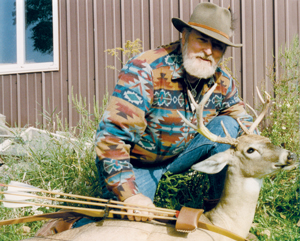
Ron has hunted all over Canada and the United States; however, he loves to hunt the local Michigan deer.
GFA: Had the Michigan Longbow Association already started when you won?
RLC: No, not for a while. After the championship I continued to promote the longbow, doing demonstrations and showing the bows, mostly throughout Michigan. In about ’82 we started an indoor longbow league at the Bellevue Conservation Club with about twenty shooters, and that prompted me to start thinking about starting a statewide longbow club. I advertised for longbow shooters to come to a meeting about those ideas and got a good turnout. The Michigan Longbow Association came out of that meeting, and as often happens, the man—me—who called the meeting became the president, holding the office for seven years. The following spring the Bellevue Club hosted the first Michigan Longbow Shoot, which we billed as a turkey shoot, and we were on our way. The popularity of the longbow continued to grow, and in ’85 we hosted the Great Lakes Longbow Invitational (now referred to as the GLLI). Within a couple of years it was far and away the biggest longbow event in the world, with people coming from all over the country and from Europe, too.
GFA: You were inducted into the Michigan Bowhunters’ Hall of Fame and served on the board of Compton Traditional Bowhunters. I think you won the Michigan knife and tomahawk throwing championship several years, too. You are a talented man!
RLC: Probably just too much time on my hands…
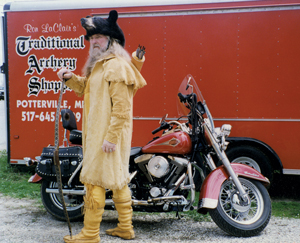
Not only a showman with the bow and arrow, Ron entertains people in other ways at gatherings.
GFA: Ron, tell us about your bow, the Shrew.
RLC: Gary Holmes and I came up with the Shrew design back in the early nineties. As much as I loved the longbow and its forgiving nature, there were times when I thought something a little shorter would be good, too. Out of that thinking came the Shrew, which was originally only fifty-two inches long. Now we offer it in various lengths to sixty-two inches, and it has become one of the most popular hunting bows on the market today.
GFA: Speaking of Shrews, what about Shrew Haven?
RLC: Shrew Haven is my hunting camp in Michigan’s Upper Peninsula. I’ve got a cabin on the Brule River that separates Wisconsin and Michigan. Each year a group of my close friends and I get together up there in November, tell lies, and bowhunt deer. It has become a special event, and someone writes about the experience just about every year.
GFA: What bow are you shooting these days?
RLC: I’m shooting Shrews in the forty-five to fifty-pound range, and I haven’t had an arrow do anything but zing through animals. There was a time when I thought you had to shoot the heavy stuff. That was part of the Howard Hill legacy, I suppose. I shot seventy-five to ninety-pound bows, and had workout bows that were 100 to 125. I’ve paid the price for that. Anyone shooting, or trying to shoot, that kind of bow weight is going have to pay the price sooner or later.
GFA: Where and what have you hunted?
RLC: I’m a Michigan whitetail hunter primarily, but I’ve hunted Wisconsin, Texas, Colorado, Montana, Idaho, Quebec, Ontario, Alaska, and probably some I’m forgetting. I’ve chased and shot mule deer, elk, caribou, buffalo, and black bears, and I’ve always hunted a lot of turkeys and small game.
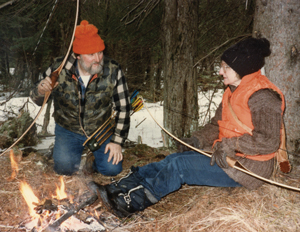
Ron and his wife and hunting partner of fifty-seven years, Nancy, taking a break while in the field.
GFA: Tell us about your marriage to your wife, Nancy.
RLC: She has been my “better half” for fifty-seven years. I have depended upon her to keep me on the straight and narrow and call her the railing on my balance beam. When I was a young man looking for my soul mate, the girls I met weren’t interested in bows and arrows. When I met Nancy, she told me that her cousin Jack White was the 1953 National NFAA Instinctive champion, and she had attended some of his tournaments. We began shooting together and were married in 1959. She has been my hunting partner and biggest supporter for most of my life.
GFA: I’m not going to let you get away without commenting on your writing. I’ve heard you recite dozens of original poems, usually at the request of others at various events over the years, and you are darned good. Will you ever put them together and come out with a book? Actually, your voice would be perfect for a DVD.
RLC: Maybe some day…
“What is there about this simple thing that captivates us so?
It’s only a simple stick and string, it’s only a simple bow.”
From “The Love of Archery,” by Ron LaClair.
Editor’s Note: Reprinted from the Oct/Nov 2016 issue of Traditional Bowhunter® Magazine. All photos are courtesy of Ron LaClair and may not be copied or used without express permission.



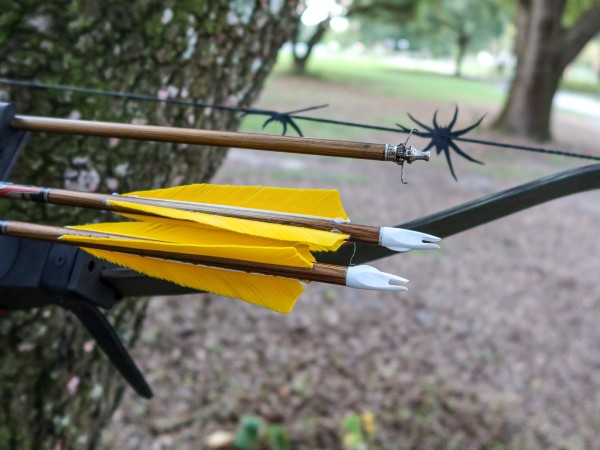


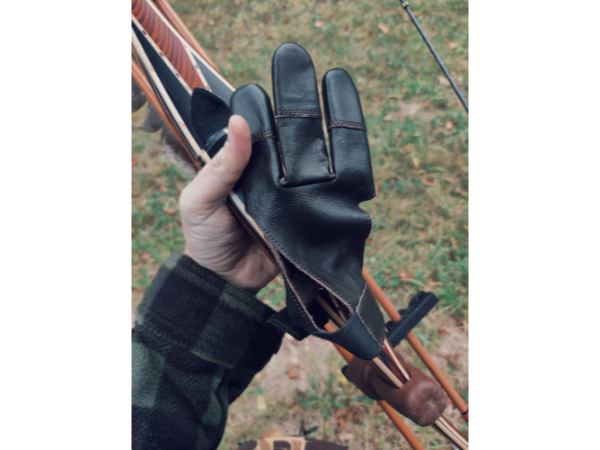
So glad to read about Ron Laclair…and his shooting 45 to 50 # bows… That’s what I’m doing in my file ol 60’s… Other guys like the macho but I like the comfort of shooting without shaking like a dog crapping razorblades when trying to hold before release… Well thanks I do believe this old DAV will be getting a Trad Bow subscription pretty soon
Great interview. What an inspiration to a fresh bowhunter like myself.
I also have been shooting a long bow awile! First bow lemonwood in1948 next was alum, about 1950 lived in Maryland and hunted rabbits in the woods Moved to California in 1954and hunted Jack rabbits in the local river beds. There was a Guy that set up and out door rang behind the local market where you could shoot I think 6 for 25 cents and win things. My friends and I would gather all are 25 cents and I would shoot I don’t know what size the target was but 3 in the gold and you would win a arrow . I would usually come home with 6 60 8 of these. After awille the guy offered me a job pulling arrows and showing people how to shoot my pay for the 3 hour stunt was 6 arrows which I shared with my friends. Grew up and went to Vetnom got shot and come home In 1967 was married in 1963 and only shot accouple a year In 1970 the compound came out and I got really excited Shot this all styles bow hunter bare bow free style. In 1976 I wa in a accident and inhaled burning gas. Told I would have to leave the LA area In 1977 we sold are home and moved to Northern Ca. and opened a small Archery shop Customers stated they wanted to see what I could do hunter style. so I bought a long bow and the thrill of watching and arrow fly came back I did shoot a P&Y bare with my compound but now it’s just me my bent stick and a few arrows
Saw that Ron passed away in early May of this year (2022). RIP, Longhunter!
~Kees~
Fantastic article by Mr. Asbell.
Saddened to hear of Mr. LaClair’s passing. A true icon of our sport and Trad lifestyle.
I’m reading this now, having learned of Mr. LaClair’s passing. My first pastoral call was in Michigan and I was becoming interested in archery at that time after years of having put the bow away to tend to college and graduate studies. I met Ron there and always found him engaging and warm. Later I ordered some of his wares and again, always found him open and willing to share with others from his treasure trove of knowledge. There were things I always dreamed of ordering but never did….how I wish I had done that, looking back. I remember one exchange via e-mail with Mr. LaClair in which he told me how much he envied my days ahead shooting bow and exploring with my young children. He told me to savor those moments. I’ve taken that to heart and it’s paid many dividends and the memories have stacked up for me.
Here’s to Ron LaClair–the real deal. An original. An inspiration. Peace be with you.